Atmospheric and turbocharged engines: differences in combustion systems

UAportal has prepared a comparative characteristic of atmospheric and turbo engines. It shows significant differences in combustion systems, sensitivity, and fuel efficiency.
Power
The combustion systems of atmospheric and turbo engines differ significantly. In an atmospheric engine, fuel is mixed with air and ignited by a spark plug.
A turbo engine, on the other hand, uses compressed air from a turbocharger to increase engine efficiency and power. Thanks to the turbocharger, a turbo engine can develop more power than an atmospheric engine.
Sensitivity
Another significant difference between the two engines is their responsiveness. An atmospheric engine responds faster to throttle openings due to its simpler design.
In contrast, a turbocharged engine experiences a delay before the turbocharger fully spins up, resulting in a slight lag in throttle response. This delay, known as turbo lag, can be minimized in modern turbo engines thanks to advanced turbocharging technology.
Cost
Atmospheric engines are generally simpler and cheaper than turbo engines. Turbo engines, with their turbocharging systems, require more components and more careful design, which leads to higher production and maintenance costs.
Repairing and replacing turbocharger components can be costly, which can offset the benefits of increased fuel efficiency in the long run. However, recent technological advances have made turbo engines more reliable and affordable.
If you want to get the latest news about the war and events in Ukraine, subscribe to our Telegram channel!
